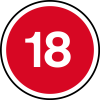Is bigger always better? Throughout the first evening of the Tattersalls Craven Breeze-up Sale one could have been forgiven for thinking that a rise in the number catalogued for the first of the European sales in this sector was not necessarily a good thing. At 202 in the book and 166 ultimately offered across the two days, this was the largest Craven Sale since 2007 and up significantly from the 164 catalogued and 134 offered last year.
For reasons that are hard to fathom, ungraded sales, with horses sold merely in alphabetical order of their dam’s name, can often be wildly disparate in regard to results from the different sessions. While Tuesday evening’s trade looked on the tough side, with the clearance rate dropping to 69% from last year’s 78%, and a 9% and 10% slide in the average and median figures, Wednesday came rallying with a late charge to level things up considerably. A final-day clearance rate of 84% meant that overall the sale settled at 76%, largely the same as 2022, with the average up by 5% and median down by 11%.
The buying bench had its usual international feel, though Amo Racing, which spent just over 1.5 million gns under various guises at last year’s Craven Sale, was a notable absentee. Ironically, Kia Joorabchian’s operation then won the following day’s G3 Craven S. with Arqana breeze-up graduate Indestructible (Ire) (Kodiac {GB}).
As ever, we hear about the big touches, such as Roderick Kavanagh and Cormac O’Flynn turning a 42,000gns December yearling into a 625,000gns breezer, but for every hit, there are plenty of misses. Those operating in the breeze-up sector are well used to spreading the risk and praying that one horse will cover potential losses on others, especially as the cost of the yearlings now turning up at breeze-up sales has risen considerably.
The number catalogued across the sector is also rising. Last year saw the introduction of the Goffs Dubai Sale during the Dubai World Cup week. Though this takes place in the Middle East, we can pretty much count it as a European sale, featuring as it does the same group of consignors. Across the six breeze-up sales, from Goffs Dubai in March, to Goresbridge in late May, a total of 1,115 juveniles have been catalogued this year, which is an increase of 92 (9%) from 2022.
The question on the minds of most consignors will be whether or not the specialised sector can sustain such an increase. In this sense, the breeze-ups may even have become a victim of their own success to a degree, following a banner year in which the headline horses were the Classic winners Native Trail (GB), Cachet (Ire) and Eldar Eldarov (GB).
At the top end of the Craven market, 10 horses sold for 250,000gns or more in both this year and last. This time around, 59 reached six figures, compared to 46 in 2022.
Vendor views
Matt Eves is the managing partner of Star Bloodstock, which, like many consignors, had mixed results at the Craven Sale. From an original draft of four, one horse was withdrawn, one failed to reach her reserve, another sold for two and a half times his yearling price, while another had a setback after breezing well.
“From a personal perspective, it was a rollercoaster,” said Eves candidly. “We had a Sea The Stars (Ire) colt on the first day, and he breezed really well and we had everybody looking at him and everybody on him. And then he comes out and he’s got a slight lame step and suddenly it’s a nightmare. So I went from having a horse that I was thinking was going to make 300 to 400,000 to having a horse that got 165,000 and nobody bidding in the ring.”
I’ll be fascinated by the end of the year to see if the increased volume of horses has meant the spend has gone up or if we’ve had the same spend spread thinner – Matt Eves
He continued, “It felt, for most of the sale, that the catalogue was too big. If Tattersalls want to carry on doing a catalogue of this size, they need to look back to the success they had in 2020 [during a season interrupted by Covid] when they had an Ascot section and a Craven section. And if they go back to doing that, then from a consignor perspective it will feel a lot better, to go back to that split so you’ve got the speedy types in one bit of the book and you’ve got the more expensive horses in the other. And what you had then was people coming in, they were looking for that Ascot horse, and you had the guys on the ground who would buy one for 40 grand. So if I got one that hadn’t quite breezed like I’d hoped in the Craven section, I had a man on the ground who would give me 40 grand for it, whereas I didn’t have that this year.”
Eves also believes that a change in format would help proceedings. “The sale is always too long, the way it is spread out,” he said. “The after-racing factor doesn’t really have a massive impact in terms of getting people in so you need to think of a better way to do that. What they did in 2020 actually worked really well.”
He added, “I’ll be fascinated by the end of the year to see if the increased volume of horses has meant the spend has gone up or if we’ve had the same spend spread thinner.”
Brendan Holland of Grove Stud sold all three horses offered at the Craven, with two making a tidy profit, including the most expensive filly of the sale, a daughter of Night Of Thunder (Ire) bought for €90,000 and sold to Kerri Radcliffe on a behalf of an unnamed, new London-based client for 600,000gns.
“One of the main things from the first two sales has been the poor clearance rates,” Holland said. In addition to the listed clearance rate of 76% at Tattersalls, the Dubai Sale weighed in at roughly the same on 74%.
“And there did seem to lack a middle market. On a positive note, there’s new buyers for the top lots and there are more international buyers. They had an increased catalogue, the average did hold up, and the aggregate jumped accordingly. But on the back of such fantastic results last year in particular, and for a few years now, we would like to have seen a stronger clearance rate really, there’s no doubt about that. I mean, it’s a tough sector of the industry. You have to perform. It’s not forgiving. It is about separating them and trying to find the good ones. I accept that.
“We’ve done okay so far, but the worry this year starting the season was that there’s an increase in the numbers overall being sold. I think the sales companies have struggled to contain the numbers, understandably. They’ve been inundated with applications. But it’s been proven over the last 10 years that there is only a certain market for a certain number of breeze-up horses, and it’s not a thousand; it’s not anywhere near that. So I would think the theme will remain the same for the rest of season. There’ll be plenty of money there, but there will be poor clearance rates.”
Holland also believes that there is a misconception that ‘better’ horses are being held back for the Arqana sale in mid-May.
“As vendors, we keep hearing it, but we’re selecting in January, and we have to remind them by the first week in February,” he noted. “No-one knows in the first week of February who the best ones are. We pick them based on suitability for an early sale and a later sale, and it’s a different type of horse. It’s nothing to do with ability.
“I would traditionally have more late-maturing horses than early-maturing horses. I would struggle often to find what I would consider suitable Craven horses. I mean, I had three this week, I wish I had more, but when I sit down and go through the bunch, the drafts that I’ve bought, that’s all I felt were suitable for a high-class early sale, which is what the Craven is.
“But as regards the better ones going to France, that’s a ridiculous statement to make really, if you think about how the horses are selected in the first instance. We can’t be selecting abilities in January because we don’t know then.”
Buyer views
A skilled selector of young horses, Richard Ryan was in action at the Craven sale and signed for a Starspangledbanner (Aus) colt who will run in partnership for Teme Valley and Coolmore. A recent breeze-up purchase of his, the Group 1-placed French Claim (Fr) (French Fifteen {Fr}), runs in Saturday’s Listed Vintage Crop S. at Navan.
From a buyer’s perspective, Ryan opined that the middle market at the Craven was stronger than he had anticipated. He said, “I have been around a little while and I couldn’t value accurately even closely on occasion. I was wide of the mark on many occasions to the tune of them far exceeding what I expected them to make.
“If you take the sums of some of those higher-echelon lots around the 600,000 mark, what would that get you in Book 1? Would you expect to find something by a proven, Group 1 or Classic-producing stallion? Highly likely. From a very high-class page with a very effective broodmare sire that may even have stakes pretensions under the first dam? Highly likely.
“Spending that sort of number on a breezing two-year-old in April by a sire that has had a couple of maiden winners on occasion, that’s all, and nowhere near Group 1-producing level yet, from some indifferent pages as well, and the fact that it has been asked to achieve a sub-12 second furlong for one or two furlongs, if at all, is actually head-scratching. In the global market for proven horses in training, £600,000 will get you a stakes winner. So I scratch my head a little bit at the rationale of some of those upper-echelons figures, but if two people are bidding against each other, then so be it.”
I was wide of the mark on many occasions to the tune of them far
exceeding what I expected them to make – Richard Ryan
He continued, “If you take a Sea The Stars or Dubawi, or for example Wootton Bassett, or a nice No Nay Never, something that has a rake of evidence supporting it, then there will be numbers of people willing to bat against each other. But even those by middle-market stallions, that weren’t the dearest individuals as yearlings, probably aren’t quite there yet and whose breezes were just adequate, were far exceeding my valuations in the mid-ranges, so I genuinely felt wide of the mark in terms of rationale behind the hammer fall this week.”
Ryan, whose previous breeze-up purchases also include the stakes winners Mitcham (Ire), Peace Offering (Ire) and Buxted (Ire), added, “The breeze-up sector is an incredible indictment of the skills of the vendors. It shows the enormous depth of horsemanship they have as a wider team. It is quite impressive to say the least that they are able to produce a horse at this time of year, keep it intact without overdoing it, and giving the trainers that follow on cause for confidence.”
Anthony Stroud is also no stranger to the full range of bloodstock sales and has enjoyed success through breeze-up purchases Native Trail, Sir Gerry and A’Ali (Ire) among others. At this year’s sale he signed for the co-top lots, one for Godolphin and the other for an undisclosed client, among four purchases.
Regarding the increase in numbers this season, he said, “There’s no doubt that the breeze-up sector is a very good medium for buying horses but it is difficult to know where all the clients will come from.”
Of the Craven Sale in particular, for which the horses breeze on the turf of Newmarket’s Rowley Mile on the Monday, followed by two post-racing sale sessions on Tuesday and Wednesday, Stroud added, “I think what’s very difficult is that as the weather improved the ground got a bit better for the horses breezing later. Consistency of ground is very important for everyone, whether you start early in the morning or whether you’re the last one up. People have to take account of that when they are doing the timings and the stride patterns. Going up the Rowley Mile for Tattersalls is a very good test but the consistency is something that needs to be discussed between the consignors and the sales company.”
Stroud continued, “I think there needs to be a break of, say, 20 minutes during the breeze because it’s quite a lot for people to take on board, the concentration levels required, though they are very efficient at getting through them quickly.
“They’ve added an extra 30 horses and the last horse I bought was at 9.40 on the Wednesday night. I think that’s too late for everyone involved, especially the staff. Mind you, I don’t think it necessarily makes any difference to how the sale goes. However late a horse sells, people will be there to buy the right horse.”
The European breeze-up action moves on to Doncaster next week with the gallops session for the Goffs UK Breeze-up Sale taking place on Monday from 9am, followed the next day by the sale at 10am.
The post Market Reflections: Tattersalls Craven Breeze-up Sale appeared first on TDN | Thoroughbred Daily News | Horse Racing News, Results and Video | Thoroughbred Breeding and Auctions.






